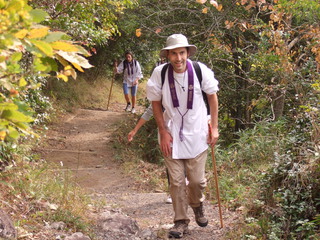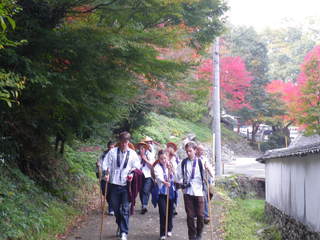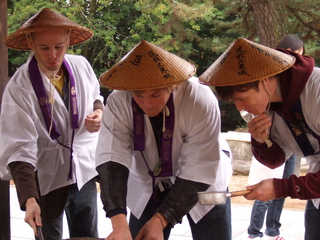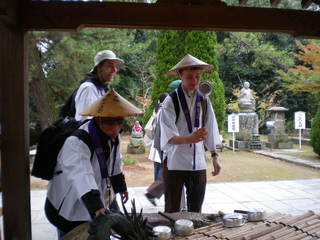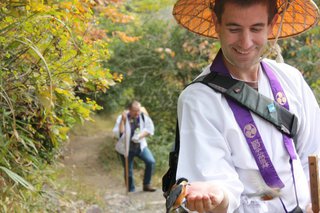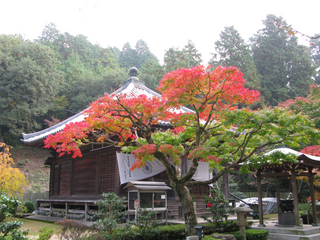On November 14th, a culturally diverse group of twenty gathered at the Kokubu Station to participate in a slice of the Shikoku 88 Temple Pilgrimage. We had signed up to hike a good 25km through the area of Kagawa known as Goshikidai. In the course of our hike we would visit three temples, and listen to culturally relevant lectures on the nature of the Shikoku 88 temple pilgrimage. In Japanese, this pilgrimage is called 'henro', so in the nature of the ALT language, a mix of Japanese and English, we were all ready to henro!
The day began rather hectically, as an incorrect train schedule led some of us astray, but we arrived with time enough to don our henro gear: a white coat, a purple sash, a hat, and a staff. While the hats were quickly demoted to hanging off our necks, (henro hair, anyone?), the staffs were proudly displayed as an item both functional and symbolic. The staff is a physical symbol of Buddha himself. As the pilgrim hikes along the henro path, he does not walk alone, because Buddha is always with him in the form of that staff.
The first leg of the hike began with hardly a slope, and I scoffed at the supposedly difficult hike. After all, I live on Shodoshima, and we have our own mini-henro - 88 temples and a henro path all our own! I have hiked the mountainous trails of my own island, and 25 km a day really didn't seem like anything different. But my arrogance was quickly rewarded with pain, as I learned how epic the Shikoku 88 trail is. Luckily we stopped to feed some birds, a lovely experience that cost us a good half hour of time. Those who stood quietly and sported a peaceful aura seemed to have the greatest success. To be that close to the surrounding nature is, I admit, a fantastic feeling, and one that recalled my own childhood memories of similar experiences in Canada. I was not expecting to experience something so familiar during this Japanese excursion.
The three temples we saw that day were stunning, particularly the last, but I admit it was the hike and the promise of autumn leaves that drew me to participate in this event. I wasn't disappointed. Goshikidai is a beautiful area in Kagawa, and I understand why the Junior High School second years travel there. Each participant had their own pace, and our group quickly spread out over the path. I took advantage of the space to walk on my own for a short while. With no voices to hinder them, the birds and wind in the leaves overwhelmed my senses, and transported me to a state of mind that I find increasingly difficult to find in my hectic Japan life: quiet satisfaction. I knew there was nowhere else I would rather be, and nothing else I would rather be doing.
The greatest pleasure of the day, however, was to be found in the company. Despite its small size, Kagawa's foreigner community rarely comes together, but when it does the results are to be applauded. The enjoyment we found in each other's company was palpable, and our camaraderie was strengthened through our sweat and pain as we tread up and down the mountainside. A Canadian from Shodoshima chatting with a Brit from Marugame - it can happen here, in our tiny and often overlooked prefecture. The chance to bond with seldom-met friends through a quintessential Japanese experience is one we should all take seriously. The Shikoku 88 Pilgrimage Event is now a not-to-be-missed event, scheduled into my calendar, for as long as I am in Japan.
